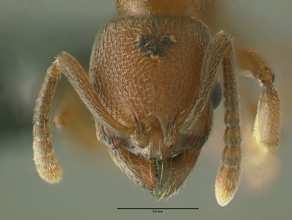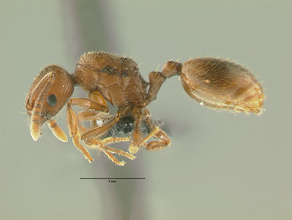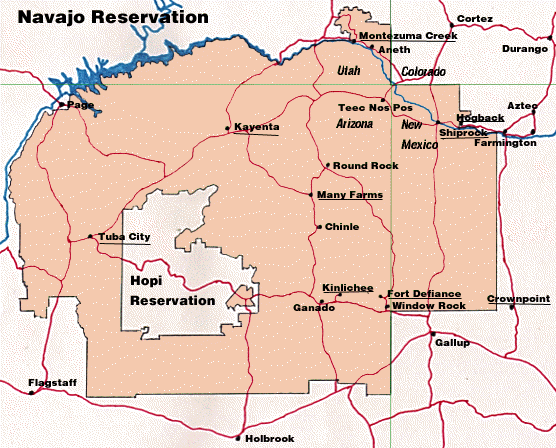- Identification
- These small ants can be difficult to identify at the species level. Snelling (1973) placed the western Stenamma into provisional groups with Stenamma californicum placed into the:
diecki group - Eyes small, EL half or less OMD; scape basically cylindrical; thoracic sculpture consisting of rugulae and punctulae; median lobe of clypeus not extended beyond clypeal margin, appearing notched in frontal view; tergite I usually smooth and shiny, but may be weakly punctulate on basal third; I usually smooth, but may be striate or punctulate; pilosity erect on head and thorax.
- and Stenamma californicum
is further differentiated:
Eyes with 3-5 facets in greatest diameter; thoracic rugulae coarse, close, interspaces moderately to strongly shiny; postpetiole shiny between rugulae; first tergite lightly punctulate on basal third or less; first sternite punctulate and finely striolate, at least at sides.
This is a rather variable, small member of the diecki group, but evidently not closely related to any other species. The sculptured first sternite, within this group, is shared with S. dyscheres, but that species is usually larger, has distinct, rather coarse rugulae on the sides of the thorax, usually has distinct longitudinal striae on the first sternite and the first tergite is not distinctly punctulate.
- Biology
- Besides knowing numerous identified collections have come from the leaf litter, we know little about the biology of this species. additional biology notes
- Distribution
- Range
- United States. California.
- Navajo Reservation Records
- Samples being processed.
- Additional Notes
- Smith (1957) provides a synopsis of the biology of species from this genus:
- The general habits of our Stenamma are more or less stereotyped. The ants are usually confined to wooded areas, where their small and well-concealed nests may be found in objects lying on the surface of the soil such as logs, stumps, branches of trees or other woody debris, nuts and acorns. More commonly the ants nest in the soil beneath rocks, logs, moss, debris or humus. Their nests consist usually of only one to a few chambers (seldom more than an inch in width or length) placed in the upper 12-18 inches of the soil. The colonies are smaller than those of most other ants, ranging from a few dozen to several hundred adults, depending on the age of the colony and the time of year. The colonies are probably largest in midsummer to early fall. The largest colony that has come to my attention had 376 adults, including workers, males, and alate females.
- Our knowledge of the life history and seasonal activities of Stenamma is based on random observations. During the winter a young colony may be expected to contain a mother queen, workers, and larvae. A few eggs have been found as late as October, but it appears doubtful that many, if any, of them overwinter. Although apparently accustomed to cool temperatures, the ants hibernate during the coldest months. In the spring, usually about April, activity begins again in the colony. The workers forage for food and the queen resumes egg laying. The overwintering larvae resume development and reach the adult stage by late spring or early summer. Adults from overwintering larvae appear a few weeks earlier than do those that develop from eggs laid in the spring. Apparently no males or alate females are produced in the younger colonies. In the older colonies these castes usually reach maturity between midsummer and early fall. There is reason to believe that males and alate females may take their nuptial flights as late as the middle of October. However, it is quite common for at least some of the males and alate females to overwinter in the parental colony and to take nuptial flight the following spring or later. It appears that some colonies produce only males, others only females, and still others a mixture of both males and females. As with many ants, it is not uncommon for males and alate females to fly at night and be attracted to artificial lights. It is believed that a single mated female is capable of establishing her colony alone and raising her first brood to maturity.
- These ants feed on animal flesh, probably mostly arthropods. Brown and Wilson (unpublished observations) found the larvae of diecki feeding on a small dipterous larva determined by W. W. Wirth as probably an empidid, and also on what they thought might be a springtail. Cole and Wilson fed caged diecki workers collembolans and thysanurans. Donisthorpe (1927) kept a colony of westwoodii Westw. under observation in a cage for at least five years and fed the ants flies and other insects, bread, cake crumbs, and honey. He found that they "did not care much for honey but ate the other food readily. No reports have come to my attention that workers of Stenamma attend honeydew excreting insects or show any interest in feeding on honeydew." Donisthorpe found westwoodii docile and easy to rear and study in cages. It is my belief that our North American species would also be easy to study in cages. Since these ants have often been found within or in close proximity to the nests of other species, it has sometimes been assumed that they are associated with other ants, but this seems very doubtful.
- Some new and interesting observations on Stenamma schmittii have been made by W. L. Brown at Lexington, Massachusetts. On October 10, 1954, he noted two foraging workers in leaf litter, and very near them two males though he was unable to locate their nest. One worker was carrying what appeared to be a small dipterous pupa, dead but in good condition; the other
worker carried an immature but dead collembolan, Tomocerus sp., also in good condition. After studying the two workers in confinement, Brown remarked:
"The workers appear to have no set way of approaching the collembolans, but merely rush their prospective prey with mandibles opened wide. The collembolans usually manage to escape if attacked in an open space between the leaves in my jar, but if caught in a crevice or pocket, they have little chance of getting away. The attack by the ants is clumsy and hurried, in contrast to the finesse displayed by the collembola catching dacetines, and there Seems little doubt that springtails form only' a part of their diet. . . .Use of the sting has not yet been observed but the rapid immobilization of the collembolan renders stinging a possibility to be considered when conditions of observations can be made more favorable than they were in the cases studied."
-
Upon returning to the exact spot where he made his first observations on schmittii, Brown made further observations as follows:
"Yesterday, November 14 was rather chilly and windy, and as before the Prenolepis were foraging in abundance in the leaf litter, as was the single specimen sent you [schmittii-author]. I have checked my notes on old collections and I find that in Pennsylvania all of my Stenamma were taken either early in the spring (mostly March) or else in October to December. I think the evidence is becoming very clear that Stenamma has unusual seasonal foraging habits geared to cool weather and resembling closely those of Prenolepis imparis, It is interesting to note the sudden abundance of Stenamma nests easily found in the forest belt where the hardwoods and northern coniferous forests blend. into one another, in places that are cool, dark and moist, where few or no other ants are present. In such places, the ants forage actively in the soil cover even on cool, rainy days. Similar conditions are indicated by what I have heard about Stenamma collections in the high Smokies and in the Douglas fir forest of the Pacific Northwest."
- Etymology
- Geographic. Named after the state of California.
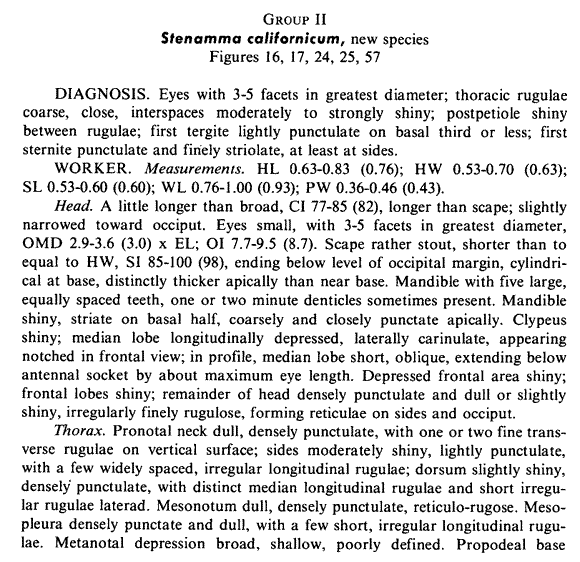


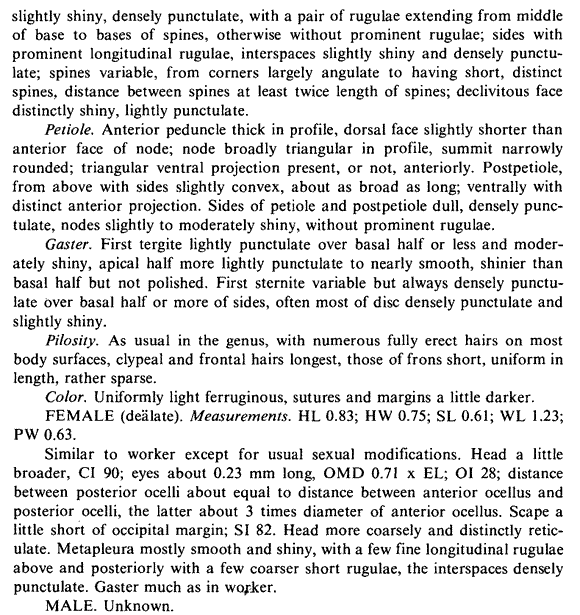

- Literature
- Smith, M. R. 1957. Revision of the genus Stenamma Westwood in America north of Mexico (Hymenoptera, Formicidae). American Midland Naturalist. 57:133-174.
- Snelling, R. R. 1973. Studies on California ants. 7. The genus Stenamma (Hymenoptera: Formicidae). Contributions in Science (Los Angeles). 245:1-38.
- A note about these publications. The literature cited here is not meant to be an exhaustive list of papers published about this species.
Page authored by David Lubertazzi and Gary Alpert
